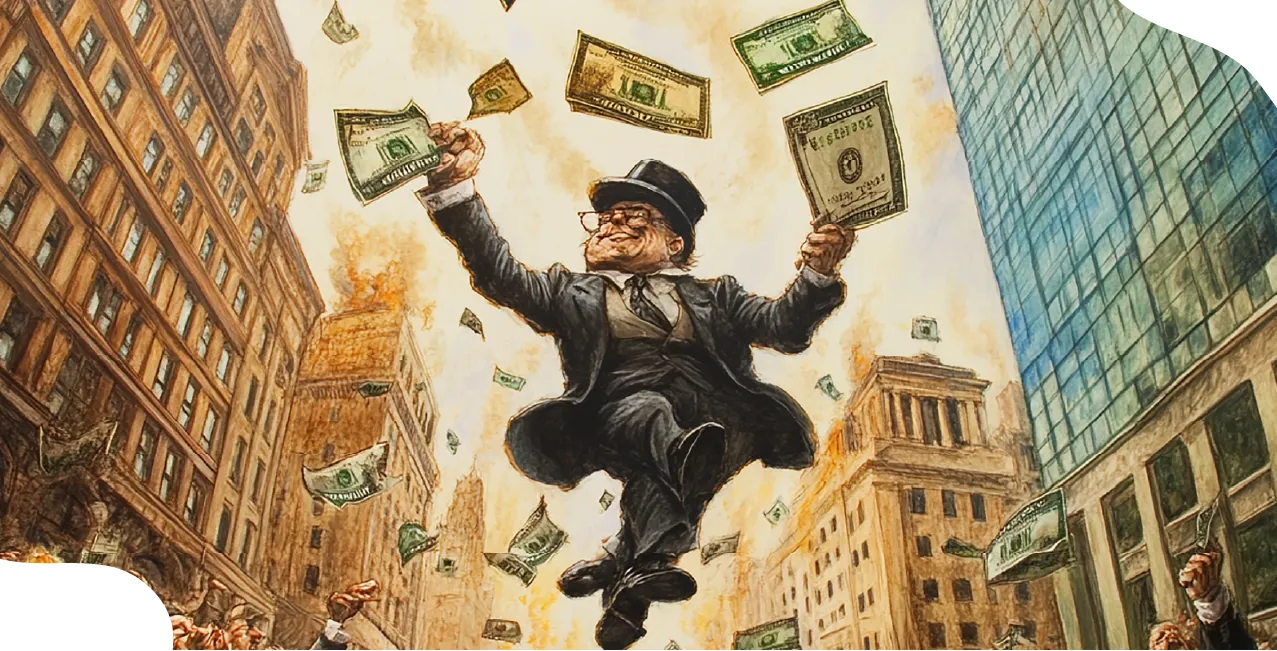
Author
LoansJagat Team
Read Time
5 Min
06 Aug 2025
What is Capitalism? Features, Pros & Cons of the Economic System
In a capitalist economy, individuals and companies own property (not the government), make their own choices, and compete with one another for profits. Jobs and prices are determined by what consumers wish to purchase.
In a capitalist economy, resources and output are owned by private individuals and companies that compete in markets to make money. Supply and demand are the main factors of prices, production, and distribution that are not controlled by the government.
Example:
- Govinda has a small grocery shop within his village.
- He purchases vegetables in the market at a rate of ₹5,000 and sells them at a rate of ₹7,000 and gets a profit of ₹2,000.
- Govinda determines what to sell and what price to charge, and he makes the profit.
- In case of the introduction of another shop in the surrounding area, Govinda may reduce prices or enhance quality to win more customers.
This blog uses easy-to-understand examples to explain capitalism and how market competition and private ownership affect our economy. See how this system impacts employment, costs, and daily life by reading on.
What is Capitalism?
In a capitalist economy, individuals and companies own property, choose what they produce and sell, and participate in free market competition to maximise profits.
Example:
- Govinda runs a small fruit stall in his town.
- He buys apples for ₹3,000 and sells them for ₹4,500, making a profit of ₹1,500.
- He decides prices based on demand; if more people want apples, he may charge a little more.
- Another fruit seller nearby offers discounts, so Govinda improves his fruit quality to keep customers.
- The profit he earns is his reward for working hard and taking risks.
In capitalism, individuals like Govinda give themselves control of their business, do fair competition and enjoy the fruits of their labour. The system promotes innovation and provides the customers with additional options.
Read More – What is a capitalist economy: Features, Advantages & Real-World Examples
What are the Key Features of Capitalism?
Capitalism is a type of economy where individuals and firms own money, resources and trade. It operates on competition, privatisation and the ability to make profits through equitable exchange.
Example:
- Manish starts a small mobile repair shop in his locality with ₹20,000 savings.
- He buys tools for ₹10,000 and spends ₹5,000 on shop rent, keeping ₹5,000 for other costs.
- He charges ₹200 per repair and gets 10 customers daily, earning ₹2,000 every day.
- After a month, his total earnings are ₹60,000, and after expenses (₹15,000), his profit is ₹45,000.
- Another repair shop opens nearby, so Manish offers faster service to stay ahead.
Table: Govinda’s Monthly Business
Key Features:
- Private Ownership: Manish owns his shop.
- Profit Motive: He works to earn money.
- Competition: He improves service when rivals appear.
- Customer Choice: People pick his shop for good service.
Capitalism allows individuals such as Manish to try to develop a successful way and get rewarded through work and some intelligent choices.
What are the Advantages of Capitalism?
Capitalism is a system of owning businesses and retaining their profits. It promotes the idea of hard work, competitiveness and new ideas that are beneficial to everybody.
Example:
- Govinda starts a small bakery with ₹50,000 savings
- He spends:
- ₹20,000 on oven and equipment
- ₹10,000 on ingredients each month
- ₹5,000 on shop rent
- Sells cakes at ₹100 each, makes 200 cakes/month (₹20,000 income)
- After expenses (₹15,000), earns ₹5,000 profit first month
- As popularity grows:
- Hires 2 helpers (creates jobs)
- Adds new cake flavours (innovation)
- Profits increase to ₹15,000/month after 6 months
- Hires 2 helpers (creates jobs)
Key Advantages:
- Freedom to Earn: Govinda keeps his profits
- Creates Jobs: Hires helpers when business grows
- Encourages Innovation: Adds new products
- Better for Customers: More choices, better quality
- Rewards Hard Work: More effort = more success
Also Read - What is a Mixed Economy? Meaning, Features & Examples Worldwide
Capitalism encourages hard work and creativity, which helps small businesses like Govinda's bakery expand. It benefits society and business owners by generating jobs, improving customer products, and allowing entrepreneurs to keep their profits.
Disadvantages of Capitalism
When the rich get richer and the poor struggle, capitalism can lead to inequality. Businesses may ignore social needs for profit. Small businesses frequently lose to large corporations, and workers may be exploited.
Example: Govinda’s Bakery Struggles
- Govinda’s bakery faces challenges after 1 year:
- A big chain bakery opens nearby, selling cheaper cakes (₹60 vs Govinda’s ₹100)
- Loses 40% customers, income drops from ₹35,000 to ₹21,000 per month
- Cannot lower prices because:
- Ingredients cost ₹10,000 per month (no bulk discounts)
- Still pays ₹5,000 rent and ₹8,000 staff salaries
- Now makes only ₹2,000 profit (vs ₹15,000 before)
- Stress increases when working 14-hour days to compete
Key Problems Seen:
- Unfair Competition: Big companies crush small shops
- No Safety Net: A Challenging period means no income
- Worker Exploitation: Govinda works longer for less
- Rich-Poor Gap: Big chain owners get richer while Govinda struggles
- Stress & Uncertainty: Constant fear of failure
The negative effects of capitalism affect small businesses most and are indicative of why pure competition is a detriment to many hard workers.
Conclusion
Capitalism is a two-edged sword, in the sense that it provides opportunities, and at the same time presents hard challenges. The case of Govinda, the bakery, expresses both sides: initially, Govinda was working hard, profiting, even employing people; that is how working and innovating in capitalism pays off.
However, as a large chain store came into the area, Govinda was unable to compete; his cash flow became low, and his efforts were not enough to compete with a large firm (he needed to expand). This is a manifestation of the evil of capitalism, where powerful businesses usually kill the small ones, making individuals such as Govinda nervous and worried.
The system does not shelter all equally, even though it succeeds faster. To have an effective capitalist system, rules must be there to prevent the death of small business entities and provide an effective reward to those who work hard for success in the real sense. It is all about balance.
FAQs
Are all jobs well-paid in capitalism?
No. Jobs that require rare skills (like doctors) pay well, but many workers (like cleaners or cashiers) earn little, even if their work is important.
Can poor people become rich under capitalism?
Yes, but it's hard. They need opportunities (like education or loans) to start businesses or get good jobs. Without help, the rich often stay richer.
Can anyone start a business under capitalism?
Yes, if you have money or can borrow it. But big companies often have an advantage because they can sell cheaper, making it tough for small businesses.
What happens if a business fails in capitalism?
The owner loses money and may shut down. Unlike government jobs, there’s no guaranteed salary success depending on customers and competition.
Why do rich people get richer in capitalism?
Because they own businesses or investments that keep growing. Meanwhile, workers only earn wages, which don’t increase as fast.
Does capitalism help the poor?
It can, by creating jobs and cheaper products. But without education or opportunities, the poor often stay poor while the rich grow wealthier.
What’s the biggest problem with capitalism?
Unfair competition, big companies push out small ones. Also, if you’re sick or old, earning money gets harder since profits matter more than people.
Can capitalism work with government rules?
Yes. Some rules (like minimum wages or safety standards) help protect workers and small businesses without killing competition.
Why do prices change in capitalism?
Prices go up if something is rare or in high demand. They drop if too many businesses sell the same thing (like phones or clothes).
Is capitalism the best system?
It’s good for growth and innovation, but bad for equality. Many countries mix capitalism with government support (like free healthcare) to balance profits and fairness.
Other Informative Pages | ||
About the Author

LoansJagat Team
‘Simplify Finance for Everyone.’ This is the common goal of our team, as we try to explain any topic with relatable examples. From personal to business finance, managing EMIs to becoming debt-free, we do extensive research on each and every parameter, so you don’t have to. Scroll up and have a look at what 15+ years of experience in the BFSI sector looks like.

Quick Apply Loan
Subscribe Now
Related Blog Post


